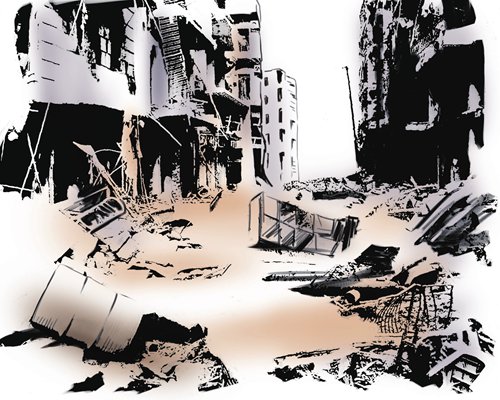
(Photo: Global Times)
The T-4 airbase in the Syrian central province of Homs was suddenly hit by a missile attack Monday near the end of the wars around Damascus in Syria. At around the same time, the US, with Britain and France, pressured the Syrian government for the recent alleged chemical weapons use in Syria through the UN Security Council. In addition, on the issue of the Iran nuclear agreement, Iran made a tough statement that if the US pulls out of the agreement, it would resume its 20 percent uranium enrichment.
The recent situation highlights the increasingly intense wrestling between the various parties inside and outside the Middle East, forming two major camps dominated by the US and Russia. The situation in the Middle East presents a chaos in which the confrontation between the two camps and reticular interweaving coexist. It is expected that the pattern's split and realignment in the future will be more complicated.
Two major camps have taken shape around the Syrian issue, with Saudi Arabia and Iran respectively becoming the main proxies of the US and Russia. They have their own following countries. From a regional perspective, Saudi Arabia is in antagonism with Iran on all sides. Israel, Turkey and Qatar, however, play complicated roles in the two camps.
Israel serves as the core member of the US camp, but it keeps a low profile in its policy. As the strength of Iran - a long-standing rival of Israel - in Syria continues to expand, Israel has to boost its relations with Saudi Arabia. At the same time, Israel's strengthened confrontation with Iran and Lebanon's Hezbollah in Syria makes Israel become the biggest suspect in launching Monday's missile attack.
Turkey has changed the most as it has become a member of the Russian camp from the original follower of the West, but it is still an "alien" in the camp. The Kurdish issue is the core of Turkey's concern, and Turkey has yet to abandon the goal of subverting the Bashar Assad regime. Therefore, on the one hand, Turkey will support pro-Turkish opposition forces in Syria. On the other hand, Turkey will continue to conduct military operations against Syrian Kurdish fighters.
Qatar is still a member of the US camp, but its regional influence has been greatly reduced after several countries severed diplomatic ties with it as it challenged Saudi Arabia over a string of regional hotspot issues.
US policy towards Syria presents the characteristics of strategic hesitation and caution. The reason lies in the fact that the US leadership and control over the Middle East have been seriously reduced due to the decline in US overall strength. Bitter lessons that the US learned from the Afghanistan and Iraq wars restrained the US from impulsively subverting the Bashar Assad regime through war.
The US intervened in the Syrian issue to deter Iran and squeeze Russia's strategic space. It resorted to various means including imposing diplomatic pressure, economic sanctions and low-intensity military strikes, but waging wars has never been taken into account.
Since US President Donald Trump came into office, the US Middle East policy has increasingly taken on utilitarian and opportunistic trends. As Trump's national security team and diplomatic team have undergone a total reshuffle, US policy toward Syria will face enormous uncertainty.
To prevent Russia from completely leading the situation in Syria, although the US is unlikely to launch a war, Washington has not given up its intervention by various means. This is the root cause of the long-term crisis in Syria.
Different from the US, Russia's policy toward Syria has its strategic features, for example, grasping the strategic initiative and the moral high ground through striking Islamic State, forming an ally system with Iran while at the same time dividing allies of the US, and expanding its presence in the Middle East. However, Russia is unable to completely resolve the complicated Syrian crisis.
The two camps dominated by the US and Russia are not impregnable fortresses, with the biggest variable undoubtedly coming from the capricious Trump administration. So far, we cannot see clear logic and content in US Middle East strategy. Therefore, in the coming period, the game in the Middle East may still be centered on the rivalry between the two major camps, and this will extend out an interwoven web entangling all kinds of forces and contradictions.


